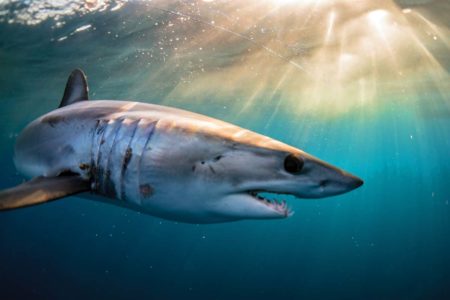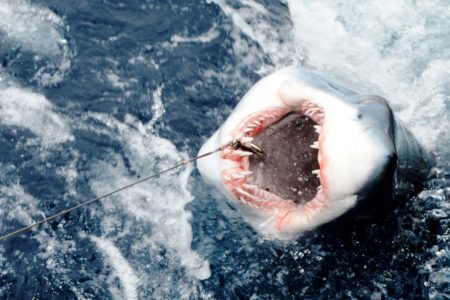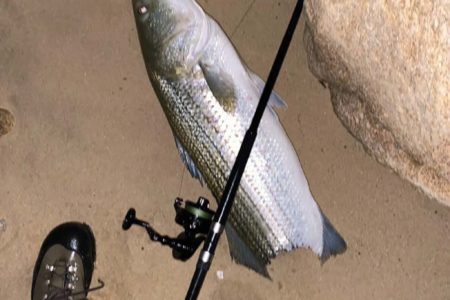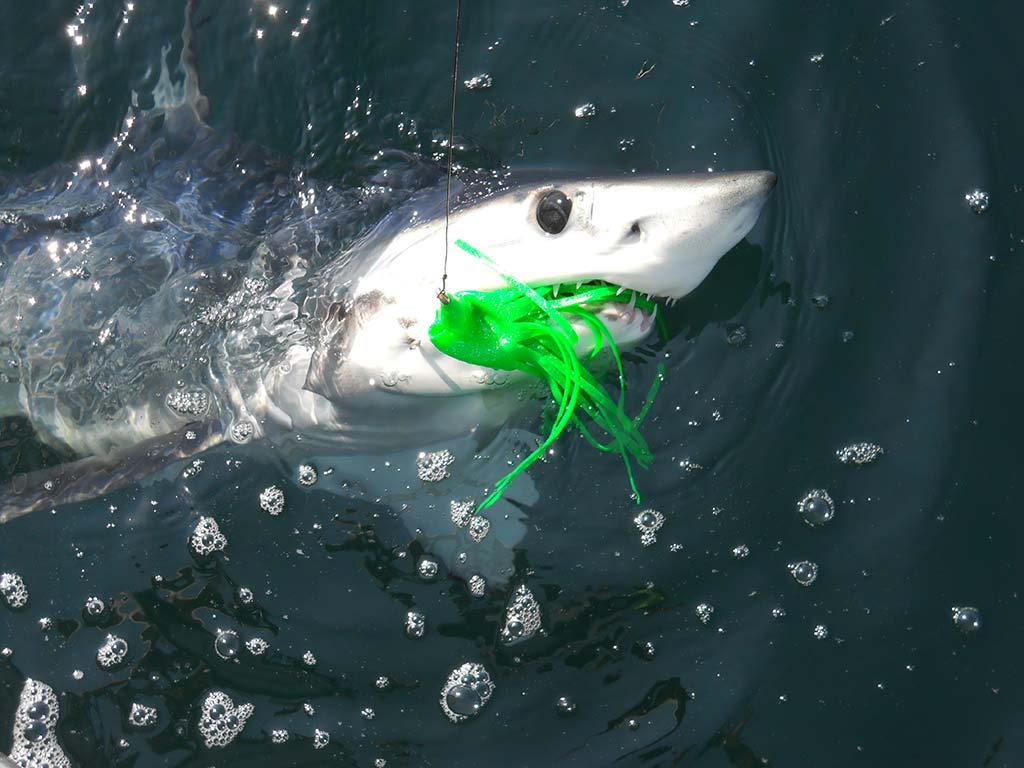
The game has changed but you can still enjoy the challenge of tangling with these toothy pelagics, while aiding in shark research.
Although catch and release is encouraged for all sharks, recreational anglers are permitted one total per vessel per trip. The following may be kept:
Hammerhead – 78-inch minimum
Shortfin Mako – 71-inch males / 83-inch females minimum
Blacktip – 54-inch minimum
Spinner – 54-inch minimum
Tiger – 54-inch minimum
Porbeagle – 54-inch minimum
Thresher – 54-inch minimum
Measurement is a straight line from the snout to the fork of the tail.
Things have changed in the recreational shark fishing business and you can’t blame this on the Covid-19 epidemic. The mako shark fishery, which had been a staple of coastal shark fishing tournaments from Capt May to Martha’s Vineyard since the mid-60s, experienced a sudden and fatal heart attack back in 2018. Although I haven’t noticed it during my numerous offshore trips over the past few seasons, NMFS scientists and bureaucrats, in league with ICAAT, generated some statistics a few years back that indicated that the shortfin mako shark stocks were in danger of overfishing and that immediate unilateral steps needed to be imposed upon us to save it. The first of these was to set minimum size restrictions on male mako sharks at 71-inches and female makos at 83-inches. Yet another restriction was to require the use of circle hooks when fishing in a competitive shark tournament or in any coastal waters where the possibility existed of running into a dusky shark, which effectively covered everywhere from DelMarVa to Cape Cod. Both recreational and charter/headboat NMFS Highly Migratory Species (HMS) permit holders were required to take a “Shark Endorsement Education Video” every season to renew their boat’s permits and pass a multiple choice test online in order to fish recreationally for coastal sharks of whatever species. According to ICCAT (International Commission for the Conservation of Atlantic Tunas), data for the eight year period from 2010-through-2017, the following six countries have been the most prolific harvesters of mako sharks in the North Atlantic Ocean based on percentage of harvest: Spain 47.8; Portugal 18.4; Morocco 18.0; USA 9.2; Japan 1.9 and Canada 1.6.
Looking at the USA numbers in more detail, the commercial part of that equation was roughly 4.2 percent of the overall 9 percent number, and the recreational part of it the remaining 5 percent. What’s interesting here is that the US commercial and recreational angling communities have been tasked with the most restrictive measures for their nominal 9.2 percent overall mako catch. Although ICCAT attempts to get its non-USA members to conform to these regulations, the problem is the consistency of enforcement. Unless every commercial vessel has an ICCAT observer onboard with the power to cut their tuna quotas on the spot for ignoring these mako regulations (and they don’t), American anglers are essentially conserving our resource so that the other folks can catch them – go figure.
For better or worse, the bottom line is that the new mako quotas have essentially killed a thriving decades long annual coastal shark tournament industry that was responsible for generating millions of dollars in coastal communities that was spent multiple times over in the purchase of fuel, bait, ice, tackle, lodging, food, clothing, restaurants, etc. Shark fishing is pretty much a recreational passion now and there are those of us that still love to set up a chum slick and drift with the wind and current, so let’s take a closer look at our “new normal” with some next-generation shark fishing tactics.
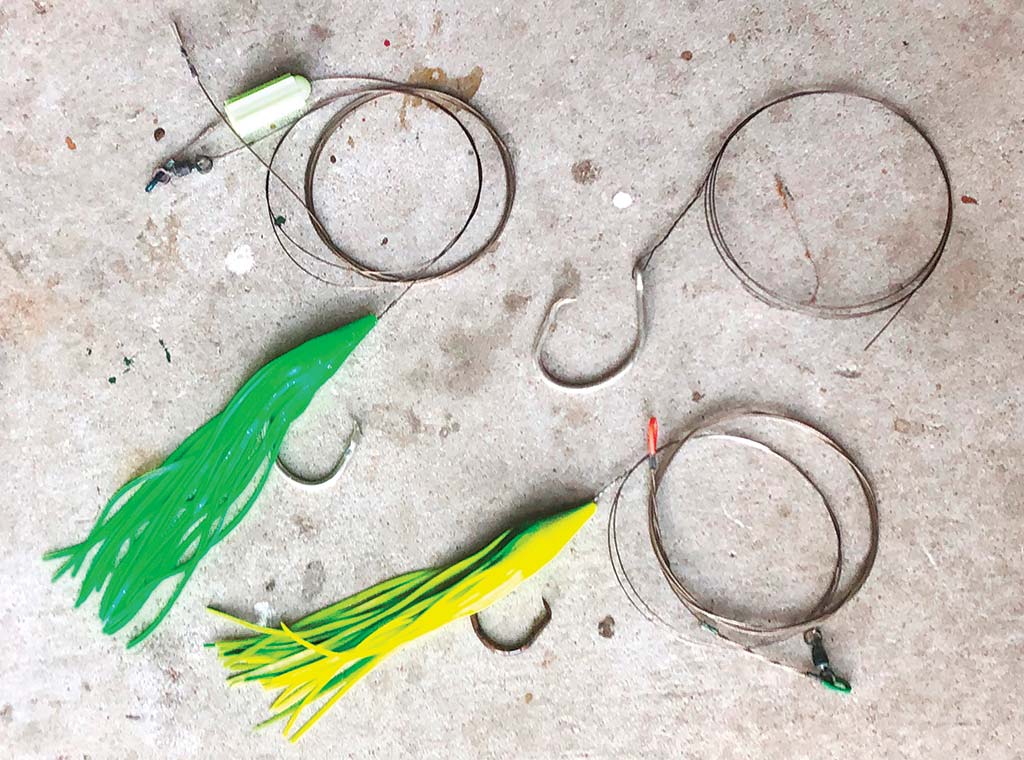
The Circle Game
According to the latest NMFS Shark Endorsement Education video, shark survival is paramount for future stocks sustainability. Therefore, unless you are fishing with artificial lures or flies, anglers who are targeting coastal sharks are required to use non-stainless steel, non-offset circle hooks when fishing in federal waters (3 to 12 miles offshore) of the North Atlantic Ocean, Gulf of Mexico and Caribbean Sea. Many coastal states have also embraced similar regulations when fishing in their inshore waters out to the 3-mile limit. Just in case you want to be clever and fish for sharks outside of the 12-mile federal waters limit in “International Waters”, I’m not quite sure what the 200-mile exclusive economic zone has to do with requiring circle hooks for shark fishing. Since I don’t have a degree in either maritime law or interpreting the code of federal regulations, I’m still using circle hooks south of the 12-mile federal waters limit.
The following are prohibited species common to our waters that must be released with minimal injury and without removing it from the water:
Dusky
Sandbar (Brown)
Sand tiger
White
The exception to the circle hook requirement is trolling lures or casting flies when a shark pops up, either in your slick or spotted free-swimming on the surface. If you have any doubt that a mako, thresher or dusky shark will hit a trolled lure, dispel your disbeliefs, for they absolutely will. I have lost dozens of trolling lures, birds, squid bars and brightly colored downrigger balls to makos, threshers and duskies of all sizes when on the troll. If it looks like food, they will attack it with a vengeance and will typically cut you off with those multiple rows of sharp teeth, but not always. If you are lucky enough to hook them in the corner of their mouth, the tip of the snout or in the side of their jaw outside of the teeth, you can bring them to boatside, but watch those teeth. No lure is worth getting bit on the hand or worse. There are many oversized shark lures on the market that employ weighted, indestructible polymer heads and wire leaders that are meant to be slow-trolled when there is no wind for drifting. They will be successful on occasion, especially when being worked around wrecks, drop-offs, dead whales, bunker schools and offshore reef areas where sharks are known to hang out looking to ambush a fresh meal.
To this day, I am not a huge fan of circle hooks and have lost more than a few makos and threshers due to poor hook sets. The drill when using circles is to wait for the fish to pick up a bait, let it run, stop and swallow it, and then let it run a second time while bringing up the drag lever and waiting for the line to come tight (while in the rod holder). Once it comes tight, reel down to put a bend in the rod to fight the fish. Sometimes this technique works and sometimes it doesn’t. The sharks often don’t read the same playbook and can frequently act differently, with an explosive non-stop run to start, and then what?
Be careful with your choice of circle hooks and be aware of the gap distance between the tip of the hook and the shank. A 10/0 J-Hook like the Mustad 7699 has roughly a 1-inch gap between the tip and the shank. To achieve a similar gap, the equivalent circle hook is usually a 20/0 model, which is the minimum distance that I believe that you need for a consistent, solid hook set. Circle hooks must be non-offset and non-stainless steel.
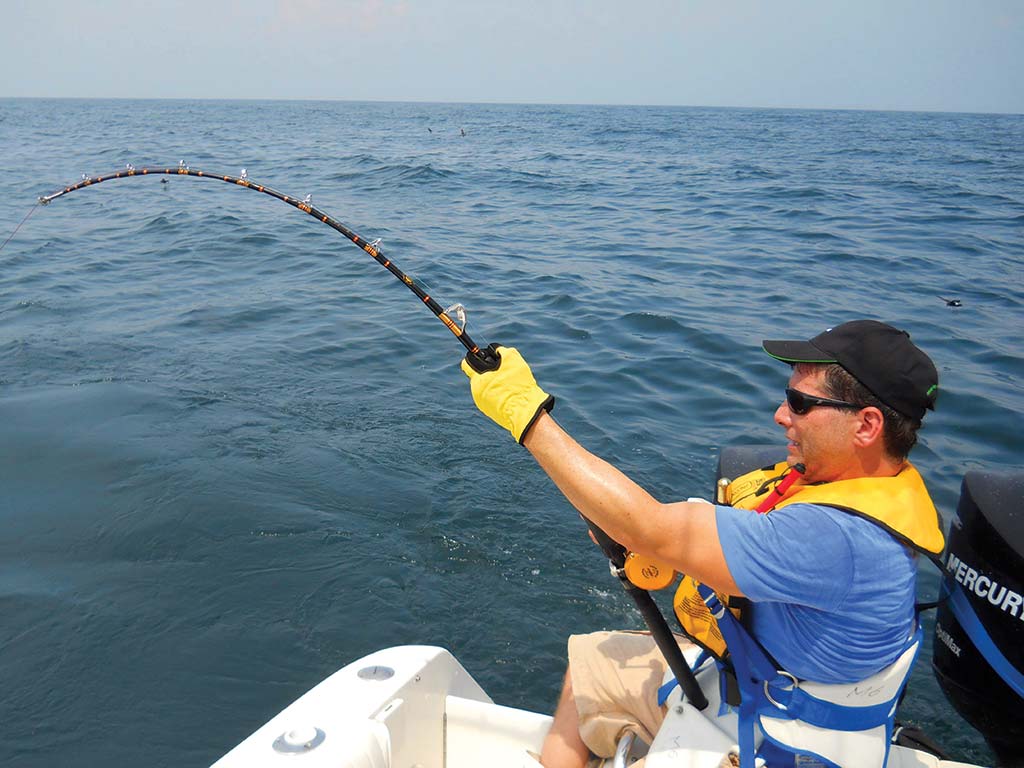
Lighten Up
Since my shark tournament fishing days are in the rear view mirror due to the current lack of competitive contests, I have gravitated to a 99-percent catch and release approach and use relatively light tackle to get it done. When you think that I might be hunting elephants with a squirrel gun, fear not, for I have identified and put into service the finest light tackle gear that is equal to the task of defeating 400-pound contestants in relatively short order, while keeping angler fatigue to a minimum. The last tournament where my crew was victorious was the Oakland’s Memorial Shark Tournament back in 2017, which coincidentally was the last tournament that I entered. Angler Joe LaFace from NYPD bested a 341-pound thresher that he caught on a Penn 16 VSX outfit spooled with Western Filament’s high-visibility 80-pound TUF-Line superbraid. That diminutive 41-ounce, two-speed lever drag reel is able to dial in 32 pounds of full drag and we brought that big whiptail to boatside in only 1-1/2 hours using 20 pounds of strike drag.
My son Marc did one even better last fall in late October when he bested a 388-pound male thresher shark on a Penn 20 VISX reel, also spooled with 500 yards of 80-pound TUF-Line hi-vis braid, finished with a 100-foot top shot of 80-pound High Seas Quattro Plus camo mono. I used my fave Bristol knot with a lock to connect the mono to the braid and that must have rolled on and off the reel 50 times during the relatively short 1-hour and 13-minute fight time. Trust me when I tell you that these big 300 to 400-pound threshers are good for three to four fight times on 50W outfits. The key to success when bringing them to boatside for tag and release, or occasional harvest, is to apply max pressure with these smallish, next-gen two-speed reels. You can limit angler fatigue during the fight with a belt, harness and gloves, and then work the boat in tight circles over the fish to confuse it, and bring it up to the surface ahead of schedule.
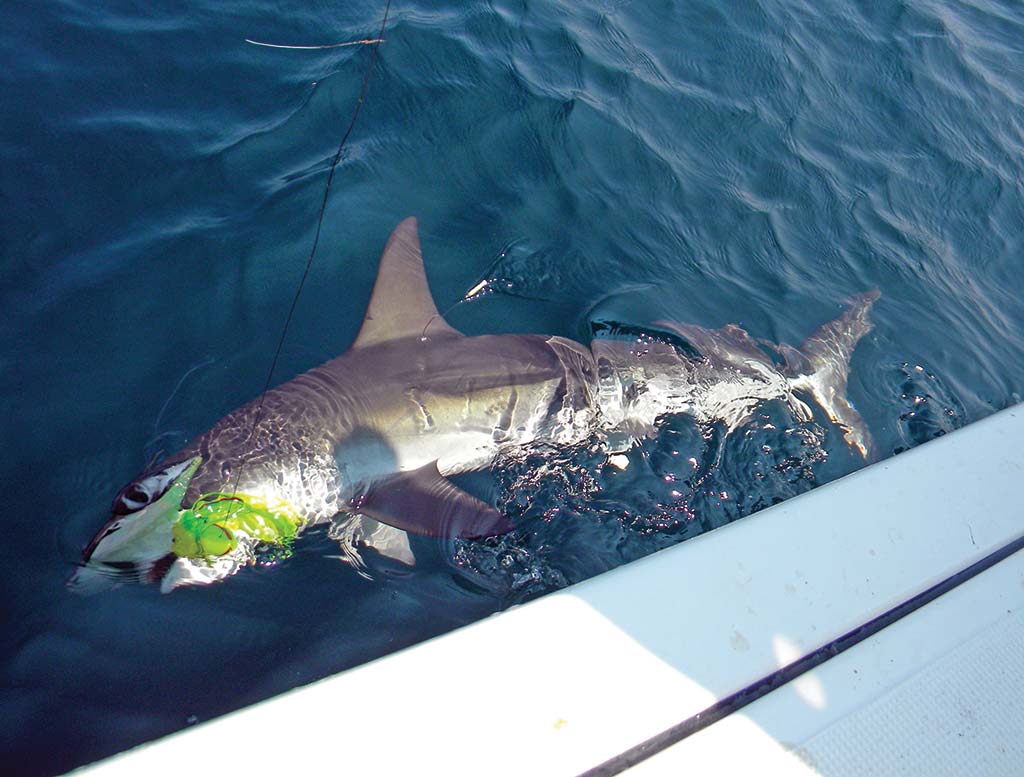
Box Of Tricks
My “shark box of tricks” has morphed over the past five decades and just about every accessory and tool that I need to be successful is in that large orange Plano container, with the exception of my mako magnet electronic acoustic device. That is stored in a separate small milk crate. The list of items changes from year to year, but the latest installation includes the following:
- fold-out bag of pre-rigged shark leaders (with circle hooks)
- bag of NMFS shark tags, with an extra needle/dart applicator
- a supply of extra non-offset, non-stainless steel circle hooks
- a lure bag of brightly colored lime, green, yellow and chartreuse rubber skirts
- a lure bag of single strand coffee colored stainless steel wire (#12-13-14), along with 400-pound cable and 600-pound swivels
- heavy duty leadering gloves
- an assortment of sharpie markers to fill out the tags
- a pair of spare wind-on mono leader topshots
- two safety lines
- a bag of #64 rubber bands
- crimping pliers and steel cable diagonal cutters (dikes)
- a serrated bait knife
- a box of crimps, haywire twist tools, a file, heavy duty swivels and snap swivels and rubber- coated paper clips to connect the breakaway sinkers to the leaders
- a shark tag flag, so that we can brag back at the dock
- an assortment of bank and egg sinkers from 1-oz to 10-ounces
- balloons or foam floats to suspend the shark baits at different levels when drifting
- corks to protect the tagging stick needle
- copper rigging wire and stainless steel needles to sew the mouths of the baits closed, to prevent spinning
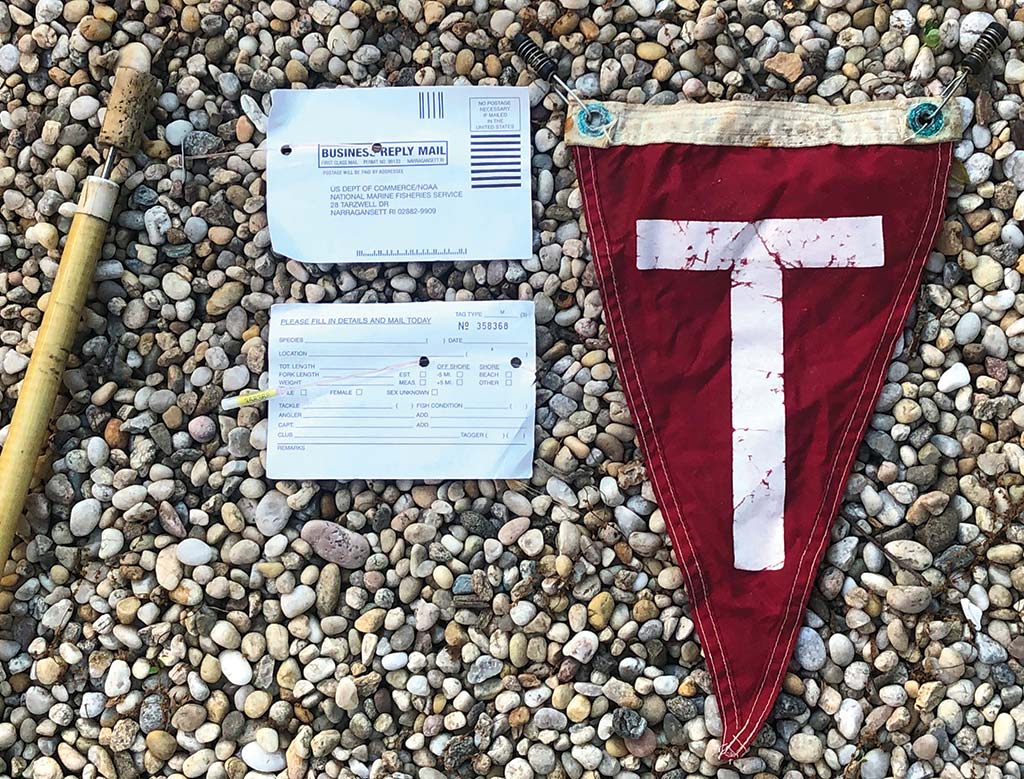
Tag & Brag
I have been an avid member of the NMFS Apex Predator Research Program almost from the beginning. Jack Casey started the tag and release promo back in the late 1960s at the first Bay Shore Mako Tournament chaired by Bill Entenmann of the Bay Shore Tuna Club and the original maker of those very delicious (not necessarily nutritious) cakes and donuts that bore his family name. This major shark tournament was also a casualty of change and ended a few years back after a 59 year run due to all of the aforementioned restrictions. I tagged my first shark back in 1976 and since then have added over a thousand more to the list. I stopped counting the hats that I received back for recaptures at 50 and have given many of them away to promote the continuing tag and release program. There is certainly a feeling of angler and crew accomplishment when bringing a large apex predator to boatside, sticking a tag into the aft base of its dorsal fin and watching it swim off unharmed into the deep. Every time one of my crew tags a healthy shark, I hope that your kids will have a similar chance to do that down the road, if they are so inclined. The interesting part of the tagging process occurs when your tag is recovered and you learn how long the fish was at liberty, where it was recaptured and how much it grew between tagging and recapture. This critical intel also confirms the migration process of where and when these fish frequent your area, which enables you to set up the timing and location of future shark fishing trips. The future of recreational sharking is “somewhat” in our control. Be sure to make the most of it and enjoy this precious resource while it is still available.

